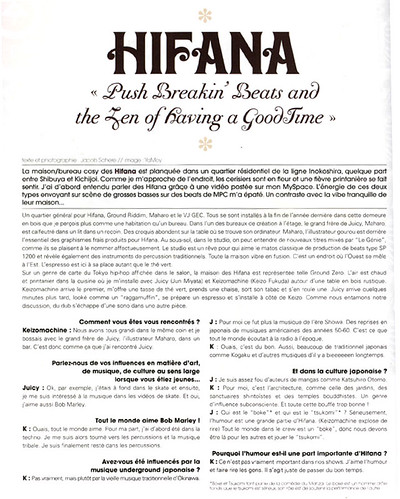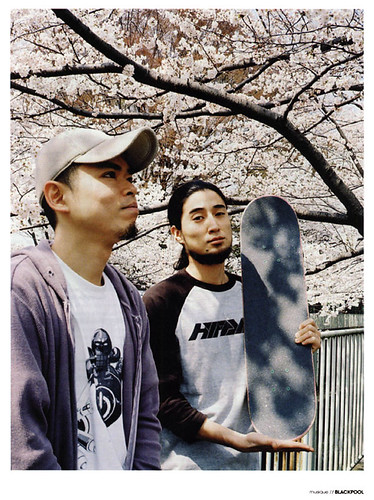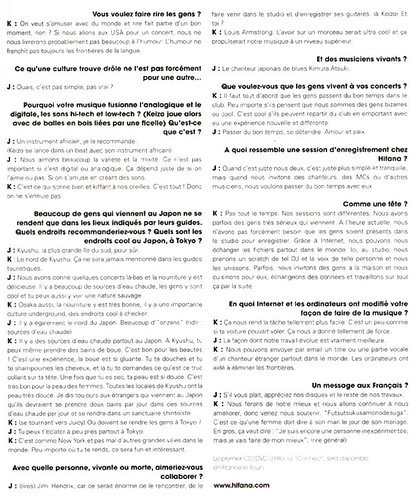Blackpool Magazine #10: Hifana Zen and the Art of Having a Good Time
Blackpool Magazine Issue #10 and Jacob Schere bring you a direct no cut interview with the fantastic duo Hifana. There brand of live SP1200 beat mixing with analog sounds is all the rage in Tokyo and now France. The article and photos were taken the end of March as the cherry blossoms were peaking. The English text is below.
http://www.blackpoolmagazine.com
Both can also be found on myspace.
check them out.
Hifana: Push Breakin’ Beats and the Zen of Having a Good Time
By: Jacob Schere text and photographs Illustration: YoMay
Interviewed on March 28th 2008
Hifana’s cozy home office is tucked away in a quiet residential neighborhood off the Inokoshira Line somewhere between Shibuya and Kichijoji. The Cherry Blossoms are peaking, as I make my way over to the Hifana House, and spring fever is in the air. I first became aware of Hifana from a fresh video that was posted to me on Myspace. The energy that these two had on stage amazed me as they would pull out a bass guitar while thumping out beats on an MPC drum machine. That contrasts pleasantly with the low tempo vibe of the Hifana House. A base of operations for Hifana, Ground Riddim, Maharo, and VJ GEC. They just moved into the house the end of last year. On my tour though the wooden house, the tranquil living space is more of home than an office. In one of the upstairs design offices, Juicy’s older brother, Maharo is out cold in a little nook of a bed. Sketches abound on the table in front of the computer. Maharo’s the illustrating guru behind most of the fresh artwork produced for Hifana. Down in the sound proof studio basement pulses some fresh tracks being mixed by “The Genius” as the staff affectionately refers him to. The studio is dream of classic beat making equipment like the SP 1200 and scores of traditional percussion instruments. The whole house vibrates with fusion. It’s a place where West meets and melts into the East. Espresso is as at home as green tea. A traditional Shoji (screen) in the living room served up with Hip Hop flavor makeover of a map of Tokyo with the Hifana House as ground zero. The warm spring air and light flood into the kitchen where I sit down with Juicy (Jun Miyata) and Keizomachine (Keizo Fukuda) at a wooden country table. Keizomachine arrives first, offers me a cup of green tea, pulls up a chair, then pulls some tobacco from a pouch and rolls one up. Juicy arrives a few minutes later looking like ragamuffin, makes himself an espresso, and pulls up a chair next to Keizo. As we get down to our little chat, dub spills out of a speaker from another room. In the end, it’s all about fresh push breakn’ beats for the world streets and having a good time.
JDS: Jacob Schere
K: Keizomachine
J: Juicy
JDS: How did you two meet?
K: We all grew up in the same neighborhood, and Juicy’s older brother, who’s an illustrator, Maharo and were I working at the bar together so I met Juicy though him.
JDS: Can you talk about your influences art, music, and culture from when you were kids?
J: Ok, for example, I was really into skateboarding, and from there I got into the music in the skate videos. Oh yeah, I love Bob Marley too.
JDS: Everybody loves Bob Marley!
K: Yeah, everybody does. For me I was first into was techno Then I got into percussion and tribal music. I next stated to play percussion.
JDS: Were you influenced by any underground Japanese music?
K: Not so much really, but old traditional music from Okinawa.
J: Well, for me it is Showa Era music. 50’s and 60’s covers of America music in Japanese, it was what was everybody was listening to on the radio back then.
K: Yeah, that’s good stuff. Also, lots of traditional Japanese like Kogaku, and old music from really WAY back in the day.
JDS: What about from Japanese culture?
J: I’m pretty much crazy about some famous manga writers, like Katsuhiro Otomo.
K: It’s the architecture for me, like gardens, Shinto Shrines, and Buddhist Temples. Kind of a subconscious influence. And all the food is so tasty!
JDS: Who’s the Boke (funny man) and who’s the Tsukomi (straight man)? Seriously, Humor is a big part of what is Hifana. [Note: Boke and Tsukomi are part of the traditional Manzai or 2 person standup comedy. The boke is referred to as the funny man and the tsukomi as the straight man, who’s job it is to support the other comedy.]
K.J: (Bust out laughing)
J: Well, we both have the respsonsibilty to be able to support each other as the straight man.
K: Everyone in the crew is a Boke, so we’ve got to be there for each other and play the part of the tsukomi.
JDS: Why is humor an important part of Hifana?
K: It’s not really an important part of our show. I like humor and making people laugh. It’s about just having fun.
JDS: Do you want to make people laugh?
K: It’s having fun with many people, and laughing if part of having a good time, right? For example if we go to America to do a show, we probably wouldn’t do much humor. Humor doesn’t always translate across cultural boundaries.
JDS: What one cultural finds funny doesn’t always work in another.
J: Yeah, it’s pretty difficult, isn’t it?
JDS: Why does Hifan’s music fuse analog and digital, hi-tech and low-tech sounds?
Keizo has been playing with two sets wooden balls attached by a string on the table.
JDS: What are they?
J: (in English) They are African Shakers. (In Japanese) I really recommend these African shakers!
Keizo begins to bust out a little beat using the African shakers.
J: We really like variety and to mix things up. It doesn’t matter to us if it’s analog or digital. It’s just if we like it or not. Having fun with the sounds we create with.
K: It’s whatever sounds good and fun to our ears. That’s it! So we don’t get bored.
JDS: Many people, who come to Japan, only go to places in their guidebooks. Where would you recommend guests to visit in Japan? Where’s the cool place to go in Japan, or Tokyo?
J: Kyushu (Japan’s largest southern Island) for sure.
K: Northern Kyushu. It would never be mentioned in a guidebook.
J: We did some shows there and the food was delicious. There are lots of hot springs everywhere; good people and you can see raw nature too.
K: Osaka, tasty eats, lots of underground culture, cool areas to check out.
J: Also, Northern Japan. Lots of Onzen (Hot Springs).
K: There are hot springs all over Japan. Down in Kyushu you can even take a mud bath. Its great for the Beauties! It’s quite the experience the mud is so slimy. You are taking shower and shampooing your hair. You wonder what is that sticky stuff still on my head. Then you are like OH Yeah I went to the mud bath. That stuff never comes out, even after you shampoo. After you towel off your skin is SO smooth. (In English) It’s good for women’s skin! All the local old ladies down in Kyushu have super smooth skin. I always tell foreigners that come to Japan that you should hit like 2 Hot Springs a day and see some local Shinto Shrines.
J: There are even hot springs here in Tokyo, they are everywhere.
K: (turning to Juicy) Where should people check out in Tokyo?
J: You can pretty much have fun wherever you go in Tokyo.
K: It’s a lot like NYC, or any other big city in the world. It’s basically wherever you go will be fun and interesting.
JDS: Who would you like to collaborate with? Living or dead?
J: (Laughing), Jimi Hendrix, because it would be great to meet him, get him into the studio and record some of his guitar licks. (to Keizo) and you?
K: Sachmo, Louis Armstrong. To get him on a track would be the coolest, and it absolutely would bring our music to the next level.
JDS: What about living musicians?
J: The Japanese blues singer Kimura Atsuki.
JDS: What do you want people to experience at a live Hifana show?
K: First of all people should have a good time out in the club. It doesn’t matter if they think we are strange or cool people. What would be cool if they can take something with them out of the club having expierenced something new and different.
J: Have a good time, kick back take it easy. LOVE and PEACE.
JDS: What’s a Hifana recording session like?
J: Whenever its just the two of us it’s a bit simple and kicked back, but when we invite vocalist, mc’s or other guest musicians we want to have a good time with them.
JDS: Like a party?
K: Not all the time. We have all kinds of sessions. We sometimes have really serious people come in. Nowadays we don’t have to record with the guest in the studio. Thanks to the Internet, we can send data back and forth all over the world. Here at the house we collect a scratch from this DJ, or vocal from this person and we put it together here. Sometimes invite people over to our house and cook for them, exchange the data, and we can bring it home with us and work on it there.
JDS: How has the Internet and computers changed how you make music?
K: It has made it is SO much easier. Its brought making music up to the same level as if you car could fly. It has given us so much power.
J: The way we can make our work progress is really easier now.
K: We can email a track a, or a vocal from a foreign artist anywhere in the world. The computers have helped to eliminate all boundaries of what can be done.
JDS: Any message to the people of France and the world?
K: How do you say Yorushiku onegaishimasu in English?
JDS: Please do your best to support us.
J: Please enjoy our CD’s, DVD’s and the other creative works.
K: We will try our best so and we will keep getting better, so come out and support us. Futsutsukusamonodesuga, which is what a bride to be says on her wedding day to her to be husband, basically I’m still an inexperienced person, but I will try my best. (Everybody laughs)
Hifana’s debut release of CONNECT CD+DVD is coming June 9th to France.



